Читать книгу The Urban Planning Imagination - Nicholas A. Phelps - Страница 29
Sites and neighbourhoods
ОглавлениеSite planning might be understood as something circumscribed to scales anywhere between an individual building and a neighbourhood of a city and is especially relevant to architects and urban designers. The site scale also figures in urban planning’s contributions to sustainable development, since regulatory urban planning has found itself in advance of the development sector when driving revisions to building codes (Rydin, 2009). An example here is the ‘Merton Rule’ (named after the London Borough of Merton): it instituted a 10 per cent on-site renewable energy policy for all new development and was subsequently taken up by 170 local authorities. The adoption and enforcement of environmental certification systems such as BREAAM and LEED have been ‘normalized’ in the property and site selections of major businesses as a result of statutory urban planning.3 Urban planning’s potential to address environmental concerns is therefore often registered in the eco-credentials of celebrated constructions, such as the BedZED development in London.
The neighbourhood scale has retained an underlying appeal within urban planning practice despite the ambiguities of the idea of ‘community’ with which it is associated. For Clarence Perry, who elaborated the neighbourhood concept associated with the Radburn design by Clarence Stein and Henry Wright, a neighbourhood possessed ‘a certain unity which is quite independent of political boundaries’ and could be ‘regarded both as a unit of a larger whole and as a distinct entity in itself’ (Perry, 2011 [1929]: 488), and perhaps the key element and innovation in this particular site plan was the hierarchical system of roads in which boundary roads took bypass traffic. In the US, Garden City ideals found their way into the Radburn neighbourhood design (Talen, 2005). However, in the curious manner that urban planning ideas have travelled, ‘the Radburn exemplar, not very influential in its country of origin … would become instead a standard point of reference in Sweden and in Britain’s New Town programme’ (Kostof, 1991: 82).
The neighbourhood scale is prominent in new-urbanist-inspired settlements and town extensions. In the US, the Seaside and Kentlands developments have been central to the success of the new urbanist movement (Passell, 2013). In the UK, Leon Krier’s Poundbury has achieved notoriety as a planning model. With its mixed uses, mixed plot sizes and tenures, Poundbury is one carefully curated example of the desire to fashion neighbourhood-level community: ‘The development approach attempts to simulate the simplicity of design yet diversity associated with the gradual organic development seen in historic Dorset towns and villages, albeit within a greatly compressed timeframe of 10–15 years’ (Thompson-Fawcett, 1998: 182). The attempt to reproduce existing settlement form has seen the criticism of inauthenticity levelled at it. However, it has travelled as a planning model of the sort I discuss in chapter 7, ‘being transformed in morsels to numerous other projects … visits to Poundbury are continual, both by British groups and those from abroad’ (Thompson-Fawcett, 1998: 185).
Rural associations have been folded into the real and imagined experience of urban kampung (village) life in Indonesia as pre-existing rural communities have been absorbed into, or developed as new neighbourhoods of, rapidly expanding cities. However, these essential neighbourhood reference points are incredibly diverse. In the city of Bandung, Benjamin et al. (1985) found that urban kampungs varied in size from under 200 families (perhaps 1,000 people) to over 60,000 families (perhaps 300,000 people). Moreover, the social capital of the kampung is ambiguous in its meaning for development (Woolcock, 1998) and the urban planning imagination.
Machizukuri, a concept of neighbourhood planning seemingly different from the top-down civil engineering tradition, has emerged in Japan. Its origins reflect a conjunction of trends – such as the rise of grassroots movements alongside governmental decentralization – and the imperative to recover and reconstruct after the Hanshin earthquake of 1995. Ambiguities surrounding the concept itself mean that both authentic and less authentic examples can exist in the same city, as in the cases of the Mano and the Rokkō-michi Station South Areas in Kobe. Thus, Mano – one of the best examples of machizukuri practice in Japan – was by 2002 ‘still a long way from the ambitious “future image” proposed in 1980’ (Evans, 2002: 452). This particular neighbourhood has become emblematic of the community planning process in Japan as a whole, as ‘There seems to be a feeling that, if Mano fails, community planning in Japan will be that much poorer’ (Evans, 2002: 456).
The neighbourhood scale of urban planning was important in socialist cities. In the former USSR, the microrayon (micro-region) formed a key neighbourhood-scale building block of the Soviet city (French, 1995). The vast majority of the extant urban fabric of Chinese cities, as they stood as recently as 1980, had been built in a patchwork of walled and gated work units or danweis. As neighbourhoods of the socialist city in China, danweis were self-contained, being places of work and residence with all the necessary urban services – schools, clinics, recreational facilities, shops and canteens. Moreover, and in contrast to the aspirational ideals of the gated neighbourhoods of liberal market economies, they were real communities given the immensely strong identification of people with their danwei.
Historic reference points for considering neighbourhood-scale planning have been joined recently by a model pioneered in one of the more densely developed cities of East Asia. Singapore’s Housing Development Board pioneered and exported its neighbourhood planning concept to China and has continued to refine it, to cater for higher densities of dwellings and population, not least by drawing on the experience of its export to and implementation in China (Miao, 2018b).
